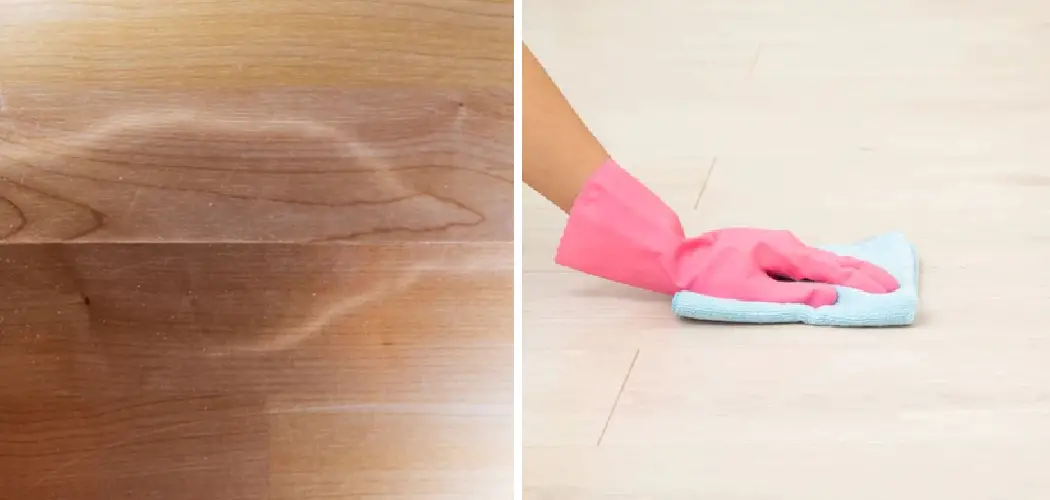Are you wondering how to get moisture out of hardwood floors? If so, then you’ve come to the right place! Moisture is not a friend to hardwood floors as it can cause warping, cracking, and other types of damage. Fortunately, several effective methods exist for removing moisture from your hardwood floors.
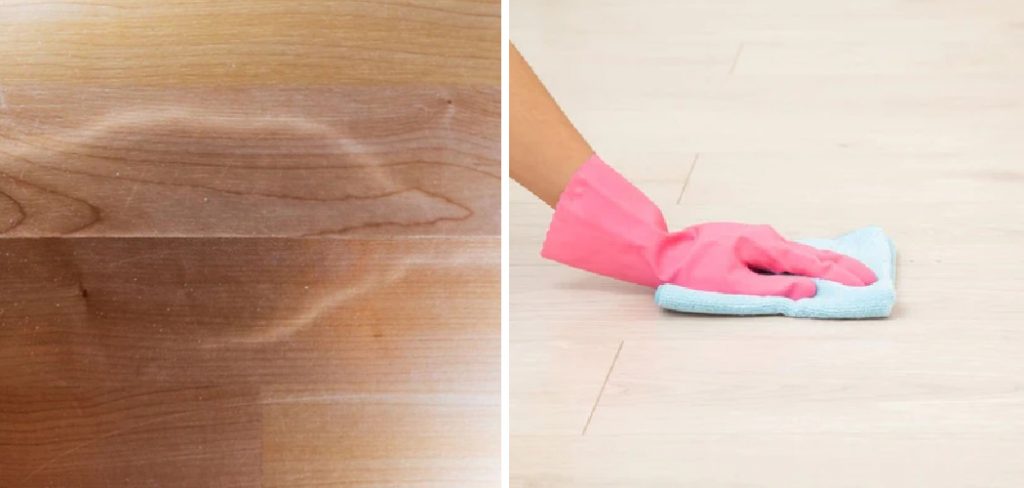
Removing moisture from hardwood floors is imperative to maintain their beauty and durability. Excessive moisture can cause warping, discoloration, and the growth of mold and mildew, which not only affects the appearance of the floors but can also create health issues for occupants. Whether the moisture is due to spills, leaks, or high humidity, quickly drying hardwood floors can prevent lasting damage.
This guide will outline practical strategies for getting moisture out of hardwood floors.
Causes of Excess Moisture
Before diving into the solutions, it’s essential to understand the common causes of moisture buildup on hardwood floors. Some of the main reasons include:
- Spills: Accidental spills from water, drinks, or liquids can cause moisture to penetrate into the wood flooring.
- Leaks: Water leaks from plumbing, appliances, or roofs can lead to excessive moisture seeping into the floors.
- Humidity: High humidity levels can cause condensation on the surface of hardwood floors, especially in areas with poor ventilation.
Knowing the reason behind the moisture problem can help determine the most effective solution for removing it.
What Will You Need?
Depending on the severity of the moisture problem, you may need one or a combination of the following tools and materials:
- Towels: For mopping up surface moisture.
- Dehumidifier: To reduce the humidity levels in the room.
- Fans: To increase air circulation and aid in drying out the floors.
- Moisture Meter: To determine the level of moisture in the wood.
- Buckets: To collect excess water from mopping or drying.
- Commercial Hardwood Floor Drying Agent: A specialized product that absorbs moisture from hardwood floors.
- Sandpaper: For removing stains or discoloration caused by moisture.
Once you have gathered the necessary supplies, it’s time to remove the water from your hardwood floors.
10 Easy Steps on How to Get Moisture Out of Hardwood Floors
Step 1. Blotting up Any Surface Water:
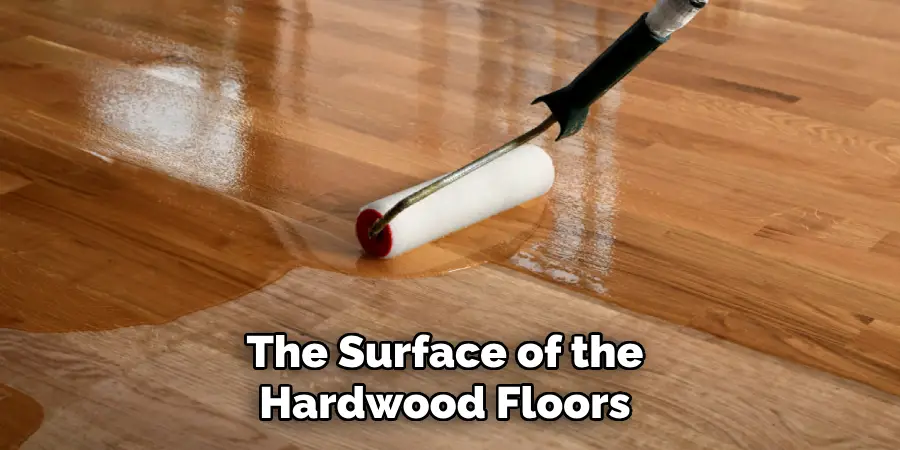
Start the moisture removal process by addressing any visible water on the surface of the hardwood floors. Carefully blot the area using clean towels to soak up as much water as possible.
Avoid wiping or spreading the liquid, as doing so might allow the moisture to seep deeper into the wood. Instead, gently press down on the towels to absorb the water and switch to dry towels as they become damp. The goal is to remove as much excess water as possible before it can penetrate through the hardwood and cause more damage.
Step 2. Using a Dehumidifier:
After you’ve managed to blot up the surface water, the next step involves lowering the moisture level in the air. Position a dehumidifier in the center of the affected area and run it at a high setting. This device will help extract moisture from the air,
Reducing the amount of vapor condensing on the floor. For best results, close windows and doors in the room to create a controlled environment. Allow the dehumidifier to operate for at least 24 hours or until the humidity level in the room falls to an acceptable level, as indicated by your moisture meter.
Step 3. Circulating Air with Fans:
To aid in drying, set up fans around the room’s perimeter pointing towards the affected areas. Ceiling fans can also be helpful if available. Keep the fans running continuously to create a constant flow of air across the surface of the hardwood floors.
This airflow helps to evaporate the moisture and carries it to the dehumidifier, speeding up the drying process. Be mindful of the positioning of fans to ensure even air distribution and prevent localized drying, which might lead to uneven floorboards.
Step 4. Employing a Moisture Meter:
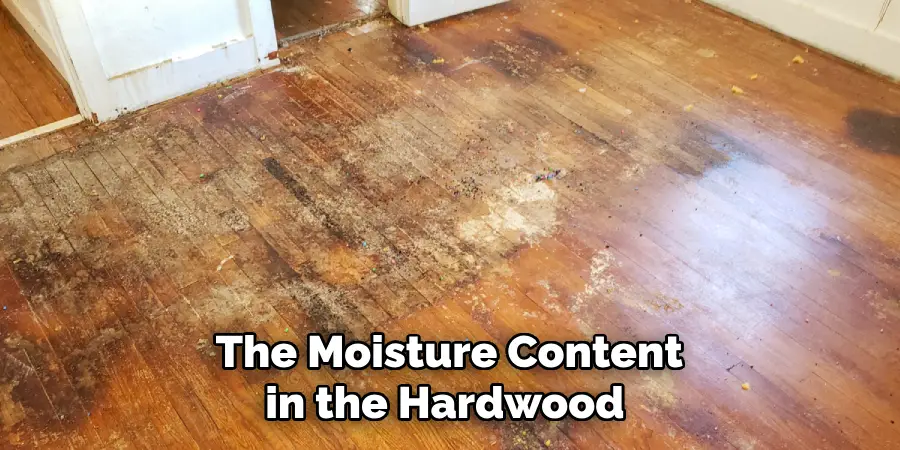
Once you’ve done as much drying as possible with towels, a dehumidifier, and fans, it’s time to assess the moisture content in the hardwood. A moisture meter is an essential tool in this process. Carefully probe different areas of the floor, especially around the wettest sections.
The meter will provide a percentage reading indicating the moisture level present. Hardwood flooring typically has a moisture content between 6% and 12%; if your flooring exceeds 12%, you’ll need to continue drying efforts. Make sure to take notes of these readings to track progress over time.
Step 5. Using Heat to Aid in Drying:
If the moisture readings from your meter are still higher than expected after using the dehumidifier and fans, you can apply gentle heat to the affected areas. Be cautious not to use too much heat, which can cause the wood to crack or split.
A safe option is to use space heaters placed at a considerable distance, giving a consistent and warm airflow over the floor. This additional heat can help evaporate lingering moisture. Continually monitor the temperature and avoid leaving heaters unattended to minimize any risk of damage to the hardwood floors or potential fire hazards.
Step 6. Reapply Drying Agents:
If moisture persists after using heat, consider reapplying commercial drying agents specifically formulated for hardwood floors. These products absorb moisture directly from the wood. Follow the manufacturer’s instructions, sprinkling the drying agent evenly across the affected area.
Allow the agent to sit for the recommended duration before sweeping it up. This method can be particularly effective after you’ve done an initial round of drying with more conventional methods. To ensure safety and effectiveness, remember to ventilate the area well while using these products.
Step 7. Sanding the Affected Area:
If the hardwood floors show staining or warping after drying, you may need to sand the affected areas. Start with a finer grit sandpaper and work up to a coarser grit if necessary. Sanding helps remove the top layers where staining may have occurred and can help level any warped planks.
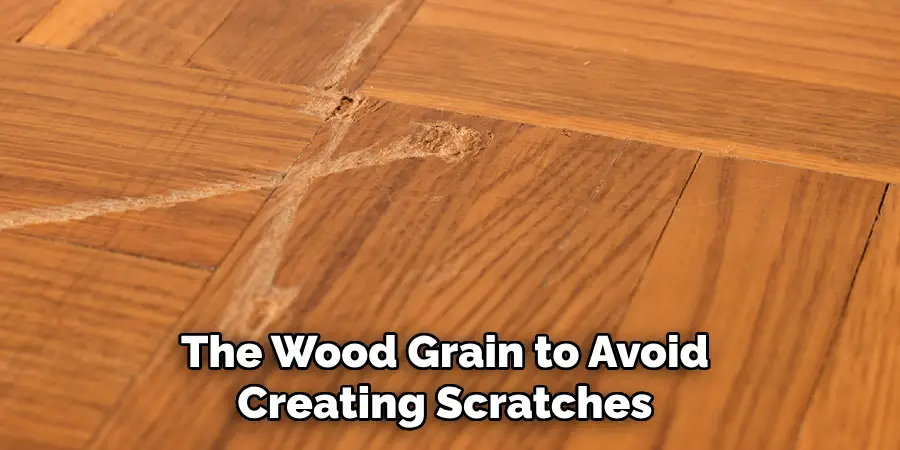
Always sand along the wood grain to avoid creating scratches across the planks. Once the sanding is complete, thoroughly clean the surface to remove any dust or particles before moving on to the next step. Remember, this step should only be undertaken if the flooring is fully dry and you have the necessary experience or have consulted with a professional.
Step 8. Refinishing the Floor if Necessary:
After the floor is arid and you have finished sanding, it might be necessary to refinish the affected areas to restore the floor’s aesthetic appeal. Refinishing hardwood floors generally involves applying a new coat of wood floor finish. Ensure the area is clean, dust-free, and completely dry before you start.
Apply the finish according to the manufacturer’s instructions, using smooth, even strokes, and maintain proper ventilation during this process. Allow the finish to dry completely, generally for 24-48 hours, before inspecting the floor to ensure a uniform appearance.
Step 9. Monitoring and Prevention:
Finally, after following the steps to restore your hardwood floors, it’s essential to monitor the affected area over the next several weeks for any signs of mold or mildew growth. Use a hygrometer to track the humidity levels in the room and maintain it within the optimal range for hardwood floors (between 30% and 50%).
To prevent future water damage, place mats at entryways, fix leaks immediately, and consider using a sealant on your floors for an extra layer of protection. Regular checks and maintenance can ensure the longevity of your hardwood floors and keep them looking their best.
Step 10. Routine Maintenance and Care:
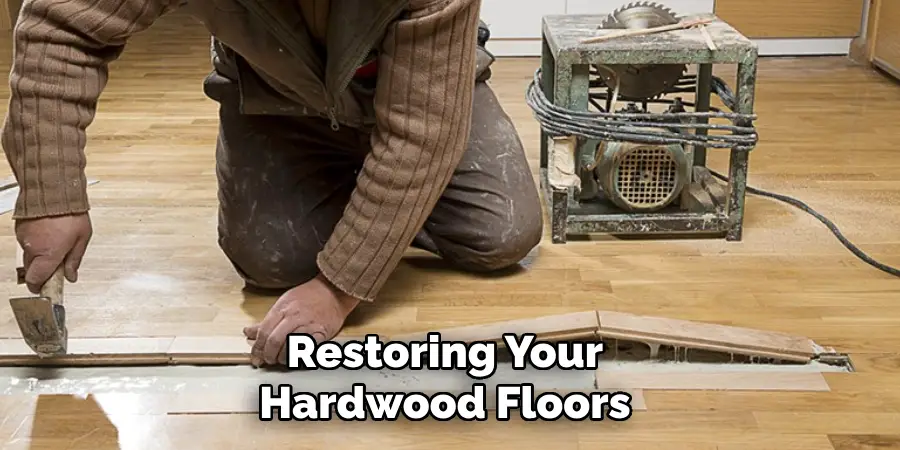
After successfully addressing the water damage and restoring your hardwood floors, implement a routine maintenance program to preserve their condition. This should include daily sweeping or dry mopping to remove dirt and grit that can scratch the surface.
Weekly cleaning with a hardwood floor cleaner will help maintain the shine and prevent soil build-up. Avoid using water or steam mops, which can damage the wood over time. Take extra caution with furniture by using felt pads under the legs to prevent scratches. Follow these routine care steps to ensure your hardwood floors remain a timeless and durable feature in your home.
Following these steps, you can effectively address water damage and restore your hardwood floors to their original condition.
5 Additional Tips and Tricks
- Use of Desiccants: Place desiccant materials in the affected area, such as silica gel packets. These can help absorb the excess moisture from the air and are particularly useful in closed spaces like cabinets above the damp flooring.
- Enhanced Air Circulation: Set up high-velocity fans and open windows to increase air circulation over the affected floor. Good airflow is crucial for drying out hardwood floors effectively.
- Address Subfloor Moisture: Access the subfloor to ensure it is also dry. Moisture can travel from the subfloor to the hardwood, so addressing any dampness from below is crucial.
- Punctual Repairs: If the flooring has suffered damage or there are gaps where moisture can enter, it is important to seal these promptly. Refinishing hardwood floors can sometimes provide a moisture barrier, preventing future moisture issues.
- Keep a Check on Humidity Levels: Constantly monitor the humidity levels in your home, especially in areas with hardwood flooring. High humidity can cause moisture issues, so it’s important to keep the levels in check and use dehumidifiers if necessary.
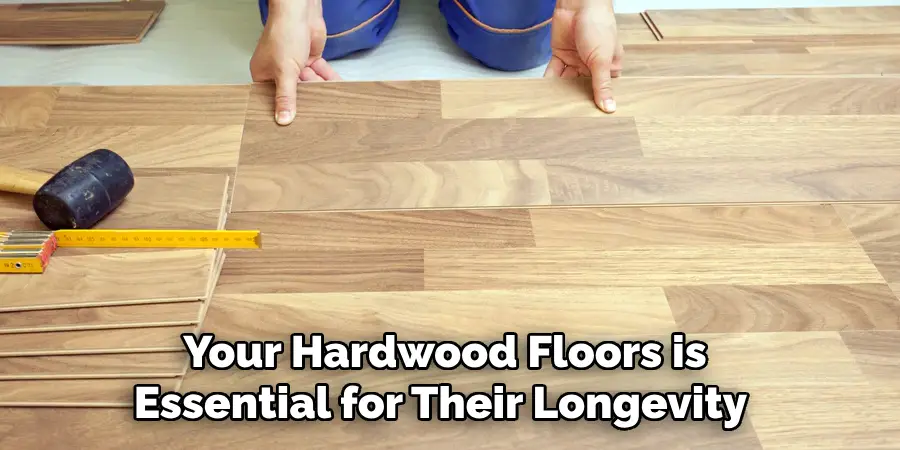
Taking care of your hardwood floors is essential for their longevity and overall appearance. By following these tips and tricks, you can effectively get moisture out of hardwood floors and prevent any potential damage.
5 Things You Should Avoid
- Avoid Overuse of Water: When cleaning, avoid using a soaking wet mop or excessive water, as this can contribute to the moisture problem rather than solve it.
- Never Ignore Leaks: Even minor leaks can cause significant water damage over time. Tackle plumbing issues immediately to prevent water from seeping into your hardwood floors.
- Skip Harsh Chemicals: Strong cleaning agents can damage the finish and integrity of hardwood flooring. Stick to cleaners that are specifically designed for hardwood.
- Don’t Delay Action: Acting quickly is crucial when dealing with moisture. The longer water sits on the wood, the deeper it penetrates, potentially causing warping and permanent damage.
- Refrain from Sealing Without Treating: Applying a sealant over a moisture-damaged floor can trap water underneath, leading to mold growth and further damage. Ensure the wood is thoroughly dry before sealing.
By avoiding these mistakes, you can prevent unnecessary damage to your hardwood floors and maintain their beauty for years.
Some Frequently Asked Questions
1. Will the Wet Wood Floor Go Back to Normal?
The condition of your hardwood floors after water damage will depend on the severity and duration of exposure. If you act quickly and follow the proper steps, it is possible to restore a wet wood floor back to its original state. However, replacement may be necessary in extreme cases, such as prolonged exposure or mold growth.
It’s always best to address moisture issues promptly to avoid the need for costly repairs or replacement. Additionally, taking preventative measures, such as regular maintenance and monitoring humidity levels, can help prevent future water damage to your hardwood floors.
Remember to always prioritize the health of your floors by addressing any issues promptly and thoroughly. With proper care, your hardwood floors will continue to be a timeless and beautiful feature.
So don’t panic if you encounter water damage on your hardwood floors – with these steps and tips, you can effectively restore them and prevent future damage. Keep your hardwood floors looking their best by following a routine maintenance program and taking preventative measures to keep moisture at bay.
2. Does Baking Soda Absorb Moisture From Wood?
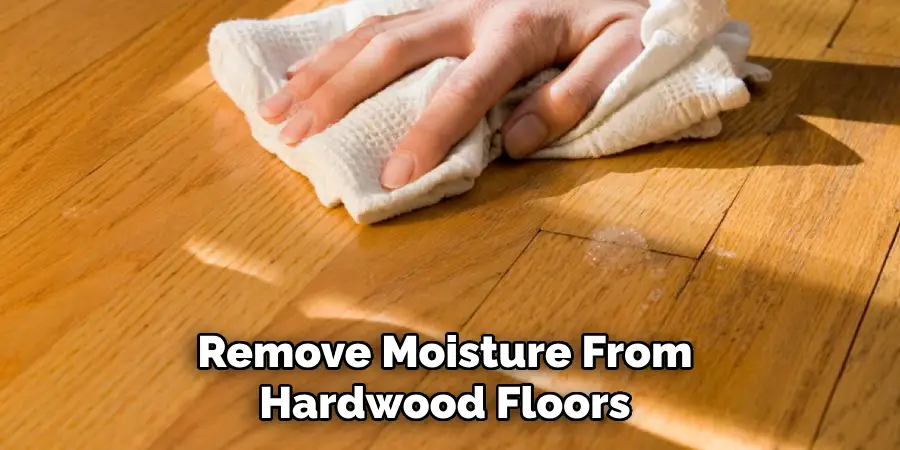
Baking soda is known for its absorbent properties and can be used to help remove moisture from hardwood floors. Sprinkle a generous amount of baking soda over the affected area, let it sit for a few hours or overnight, then vacuum it up. You can mix equal parts baking soda and water to create a paste and apply it directly to the dampness.
Let it sit for several hours before wiping it up with a damp cloth. Repeat the process until the moisture is absorbed and the wood feels dry to the touch.
Remember also to address any underlying issues causing excess moisture, such as leaks or high humidity levels.
3. How Do You Restore Dry Wood Floors?
Restoring dry wood floors often entails rehydrating the wood and addressing the environmental factors that caused the dryness. Clean the floor thoroughly to remove any dust, dirt, or debris. Next, consider applying a wood floor oil or conditioner designed to help rehydrate the wood. Allow it to penetrate and soak into the wood according to the product’s instructions before buffing it to a shine.
For a long-term solution, monitor and maintain a stable humidity level in the home, as extreme fluctuations in humidity can cause wood to lose moisture and shrink. In cases where the wood has become cracked, or the finish is severely damaged, it may be necessary to sand and refinish the floor to restore its appearance and protection.
Always follow the manufacturer’s guidelines when using any products on your floors and, if necessary, consult with a professional for more severe cases.
3. What Liquid Destroys Wood?
Several liquids can cause damage to wood, including water, bleach, and acidic substances like vinegar or lemon juice. These liquids can penetrate into the wood, causing it to swell, warp, or even rot over time. It’s essential to clean up any spills promptly and use caution when using harsh chemicals on hardwood floors.
Also, avoid using steam cleaners as they can damage the wood’s finish and cause swelling. It’s always best to use products specifically designed for cleaning and maintaining hardwood floors to avoid any potential damage.
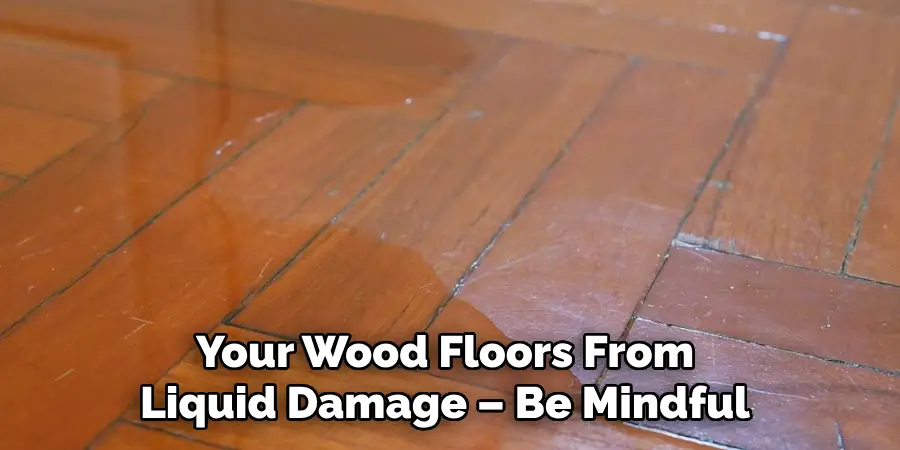
Overall, prevention is critical in protecting your wood floors from liquid damage – be mindful of spills and take precautions when using cleaners or other liquids near your hardwood flooring. Proper care and maintenance allow you to keep your hardwood floors looking beautiful and avoid potential liquid disasters. So, keep these tips in mind, and enjoy the natural charm and warmth of your hardwood floors for years to come.
Conclusion
In summary, successfully removing moisture from hardwood floors depends on a proactive and informed approach. Swift action to remove any excess water, using appropriate water-absorbing materials like baking soda, and employing suitable cleaning agents specifically made for hardwood can make all the difference in preserving your floors.
Addressing underlining moisture sources by fixing leaks promptly, maintaining optimal humidity levels, and avoiding water-retention mistakes can safeguard your investment. When simple remedies don’t suffice, professional assessment and treatment may be necessary to ensure your floors return to and maintain their best condition.
Remember, the longevity and appearance of your hardwood floors are mainly within your control, with proper care serving as the best defense against moisture and its complications.
Hopefully, this guide on how to get moisture out of hardwood floors has provided you with the knowledge and tools to handle any water damage situation and keep your hardwood floors pristine. Happy cleaning!

